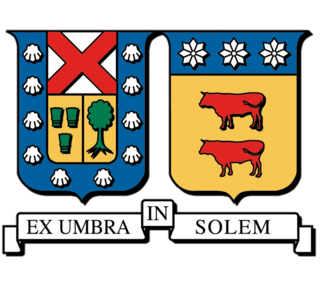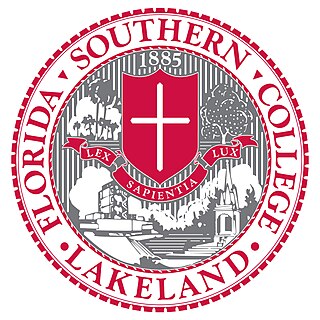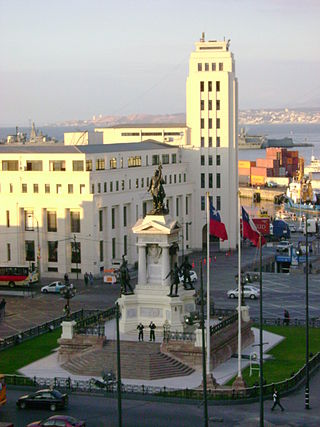Related Research Articles

Valparaíso is a major city, commune, seaport and naval base facility in Valparaíso Region, Chile.

Viña del Mar is a city and commune on central Chile's Pacific coast. Often referred to as La Ciudad Jardín, Viña del Mar is located within the Valparaíso Region, and it is Chile's fourth largest city with a population of 324,836. Viña del Mar is also part of the Greater Valparaíso area, the country's second largest metropolitan area, after the Metropolitan area of Santiago. The Greater Valparaíso Area is home to five municipalities: Valparaíso, Viña del Mar, Concon, Quilpue and Villa Alemana.

The Federico Santa María Technical University is a Chilean university member of the Rector's Council, founded in 1931 in Valparaíso, Chile.

The University of Chile is a public research university in Santiago, Chile. It was founded on November 19, 1842, and inaugurated on September 17, 1843. It is the oldest university in the country. It was established as the continuation of the former colonial Royal University of San Felipe (1738), and has a rich history in academic, scientific and social outreach. The university seeks to solve national and regional issues and to contribute to the development of Chile. It is recognized as one of the best universities in Latin America for its leadership and innovation in science, technology, social sciences, and arts through the functions of creation, extension, teaching, and research. It is considered the most important and prestigious university in the country.

The Pontifical Catholic University of Chile is a traditional private university based in Santiago, Chile. It is one of the thirteen Catholic universities existing in Chilean university system and one of the two pontifical universities in the country, along with the Pontifical Catholic University of Valparaíso. Founded in 1888, it is one of Chile's oldest universities.

The Chilean Navy is the naval warfare service branch of the Chilean Armed Forces. It is under the Ministry of National Defense. Its headquarters are at Edificio Armada de Chile, Valparaiso.

The Pontifical Catholic University of Valparaíso (PUCV), also known as Universidad Católica de Valparaíso (UCV), is one of six Catholic universities in Chile and one of the two pontifical universities in the country, along with the Pontifical Catholic University of Chile. Founded in 1928, it is located in Valparaíso Region and has about 18,000 students.
Playa Ancha University of Educational Sciences, mostly known as Playa Ancha University or UPLA, is a public university in Valparaíso, Chile. It is part of the Chilean Traditional Universities, belonging to the Council of Rectors, a select group of twenty-five chilean universities. The university has two campuses: the major one in Playa Ancha, Valparaíso, and the second one in San Felipe.

Florida Southern College is a private university in Lakeland, Florida. In 2019, the student population at FSC consisted of 3,073 students along with 130 full-time faculty members. It offers undergraduate, graduate, and postgraduate programs. The institution is home to the world's largest single-site collection of Frank Lloyd Wright architecture.

The Humboldt squid, also known as jumbo squid or jumbo flying squid (EN), and Pota in Peru or Jibia in Chile (ES), is a large, predatory squid living in the eastern Pacific Ocean. It is the only known species of the genus Dosidicus of the subfamily Ommastrephinae, family Ommastrephidae.

Montpellier 2 University was a French university in the académie of Montpellier. It was one of the three universities formed in 1970 from the original University of Montpellier. Its main campus neighbors the Montpellier 3 University's main campus, and for this reason the nearest tramway station is named "Universities of Sciences and Literature" rather than "University of Sciences". In January 2015, Montpellier 1 University and Montpellier 2 University merged into the Montpellier University.

The Adolfo Ibáñez University (UAI) is a private research university in Santiago, Chile associated with the Adolfo Ibáñez Foundation. In 1988, in accordance with new educational legislation, a university was founded based on the Valparaiso Business School, an older institution for the professional teaching in business administration founded in 1953 by Adolfo Ibáñez Boggiano. The newer university would take its name some decades later.

The Andrés Bello National University is a Chilean private university founded in 1988.

Concholepas concholepas, the Chilean abalone or Peruvian tolina, is a species of large edible sea snail, a marine gastropod mollusk. Despite the superficial resemblance, C. concholepas is not a true abalone, but a member of the family Muricidae, also known as murex snails or rock snails. This species is native to the coasts of Chile and Peru, where it is called loco, pata de burro, tolina, or chanque.

Luisa Eugenia Navas Bustamante was a Chilean pharmacist and botanist.

Tourism in Paris is a major income source. Paris received 12.6 million visitors in 2020, measured by hotel stays, a drop of 73 percent from 2019, due to the COVID-19 pandemic. The number of foreign visitors declined by 80.7 percent. Museums re-opened in 2021, with limitations on the number of visitors at a time and a requirement that visitors wear masks.

Enrique Gebhard was a Chilean architect.
Francisco Bezanilla is a Chilean-American scientist and professor at the University of Chicago. He is a past president of the Biophysical Society and a member of the National Academy of Sciences.

The Plaza Sotomayor is a plaza in Valparaíso, Chile. It is named after Rafael Sotomayor. The square is lined by buildings occupying full block-fronts of the streets that flank it. The focus of the square is the monument that honors the Chilean sailors who fell during the Battle of Iquique and the Battle of Punta Gruesa. The plaza and surrounding buildings was designated a Zona Típica on January 23, 1979.
References
- ↑ Antezanar, Tarsicio, and Bahamonde, Nibaldo (2002). "History of Marine Science in Chile". In Benson, K.R.; Rehbock, P.F. (eds.). Oceanographic History: The Pacific and Beyond. Seattle: University of Washington Press. pp. 159–160. ISBN 978-0-295-98239-7.
{{cite book}}: CS1 maint: multiple names: authors list (link)